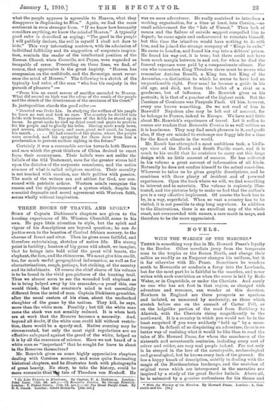THREE BOOKS OF TRAVEL AND SPORT.* SOME of Captain Dickinson's
chapters are given to the hunting experiences of Mr. Winston Churchill, some to his own. He pays little attention to style, but the spirit and vigour of his descriptions are beyond question ; he can do justice even to the beauties of Central African scenery, to the charms of forest and river. Then he gives some faithful, and therefore entertaining, sketches of native life. His strong point is lucidity ; hunters of big game will admit, we imagine, that he brings into bold relief the great wild beasts, the elephant, the lion, and the rhinoceros. We most give him credit, too, for much useful geographical information, as well as for characterisations, rough, perhaps, but striking, of the country and its inhabitants. Of course the chief charm of his volume is to be found in the vivid pen-pictures of the hunting trail. Thus we almost seem to see the wounded bull elephant as he is being helped away by his comrades,—a proof this, one would think, that the creature's mind is not essentially different from the mind of man. Captain Dickinson grumbles, after the usual custom of his class, about the unchecked slaughter of the game by the natives. They kill, he says, more than the white man. Possibly ; but till the white man came the stock was not sensibly reduced. It is when both are at work that the Reserve becomes a necessity. And, beyond all doubt, if the white man could kill without restric- tion, there would be a speedy end. Native cunning may be circumvented, but only the most rigid regulations are an effective safeguard against the greed of the white, helped as it is by all the resources of science. Have we not heard of a white man so "important" that he sought for leave to shoot in the Reserves themselves ?
Mr. Renwick gives us some highly appreciative chapters dealing with Corsican scenery, sad some quite fascinating historical chapters, and he illustrates both with photographs of great beauty. No story, to take the history, could be more romantic than tllit tale of Theodore von Nenhoff. He
• (1) Lac Victoria to Ritartamn. By Captain P. A. Dickinson. London : John Lane. [I2s. 0d. net. (e Romantic Corsica. By George Ides/rick. London: T. Fisher Unwire. [10s. 6d. not.]—(8) The Great Paciftc Coast. By E. R. Enock. London • Grant Richards. [16a. net.] was no mere adventurer. He really contrived to introduce a working organisation, for a time at least, into Corsica,—no small achievement for the "Isle of Unrest." Then lack of means and the failure of outside !support compelled him to depart; he came again and endeavoured to reinstate himself, but this time the islanders would have nothing to do with him, and he joined the strange company of " Kings in exile." He came to London, and found his way into a debtors' prison. He found his way out, it is true ; but there could not have been much margin between in and out, for when he died the funeral expenses were paid by a compassionate oilman. For one who remembers King Theodore there must be scores who remember Antoine Bonelli, a King too, but King of the Assassins,—a distinction to which he seems to have had an unquestionable right. Poor man ! he became a guide in his old age, and died, not from the bullet of a rival or a gendarme, but of influenza. Mr. Renwick gives us his portrait; it is that of a poacher of the highest rank. But the Corsican of Corsicans was Pasquale Paoli. Of him, however, every one knows something. Do we not read of him in Boswell P Napoleon also may be left out of account, for he belongs to France, indeed to Earope. We have said little about Mr. Renwick's experiences of travel. Let it suffice to assure our readers that Romantic Corsica is as well written as it is handsome. They may find much pleasure in it, and profit also, if they are minded to exchange our foggy isle for a time for the finest climate in the world.
Mr. Enock has attempted a most ambitious task, a bird's- eye view of the North and South Pacific coast, and it is much to his credit that he contrives to carry out this large design with no little amount of success. He has collected in his volume a great amount of information of all kinds. Naturally he does not confine himself to the actual coast-line. Wherever he takes us he gives graphic descriptions, and he combines with these plenty of incident and of personal experiences. Open the book where we will, we find something to interest and to entertain. The volume is copiously illus- trated, and the pictures help to make us feel that the author's pen is a very effective implement. Of course the book has to be, in a way, superficial. When so vast a country has to be visited, it is not possible to stop long anywhere. In addition to the illustrations, there is an excellent map of the whole coast, not overcrowded with names, a rare merit in maps, and therefore to be the more appreciated.














































 Previous page
Previous page